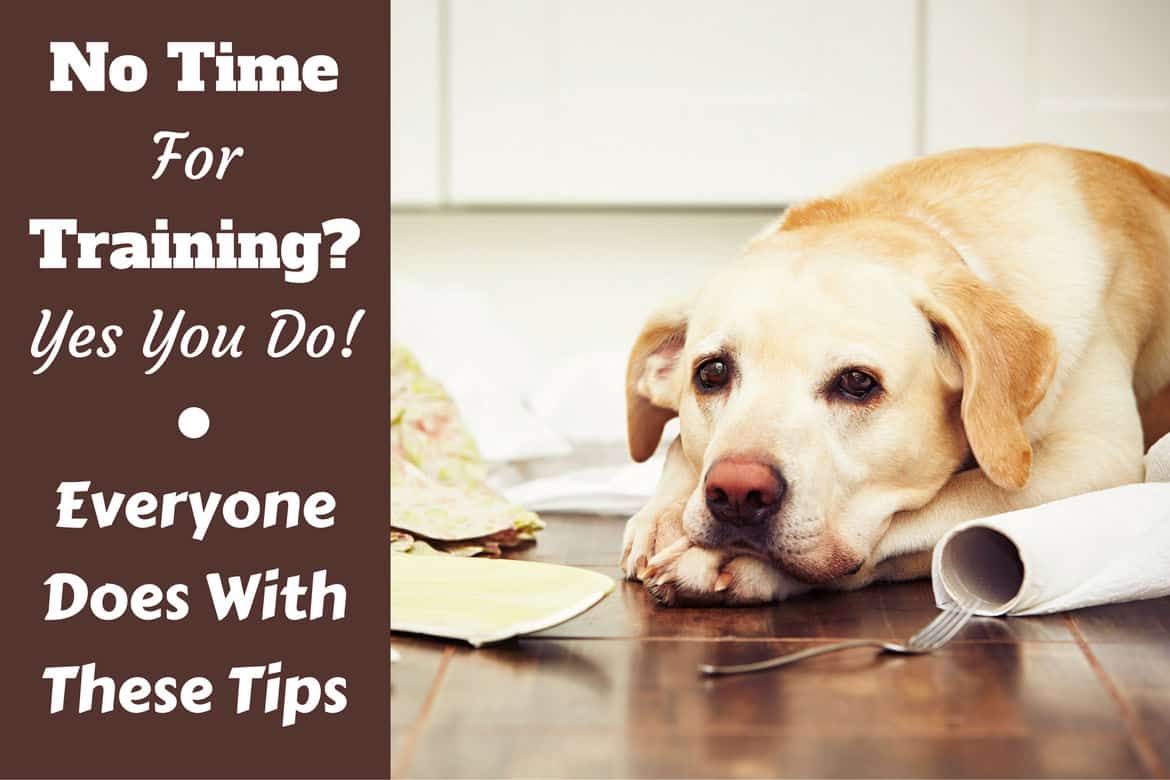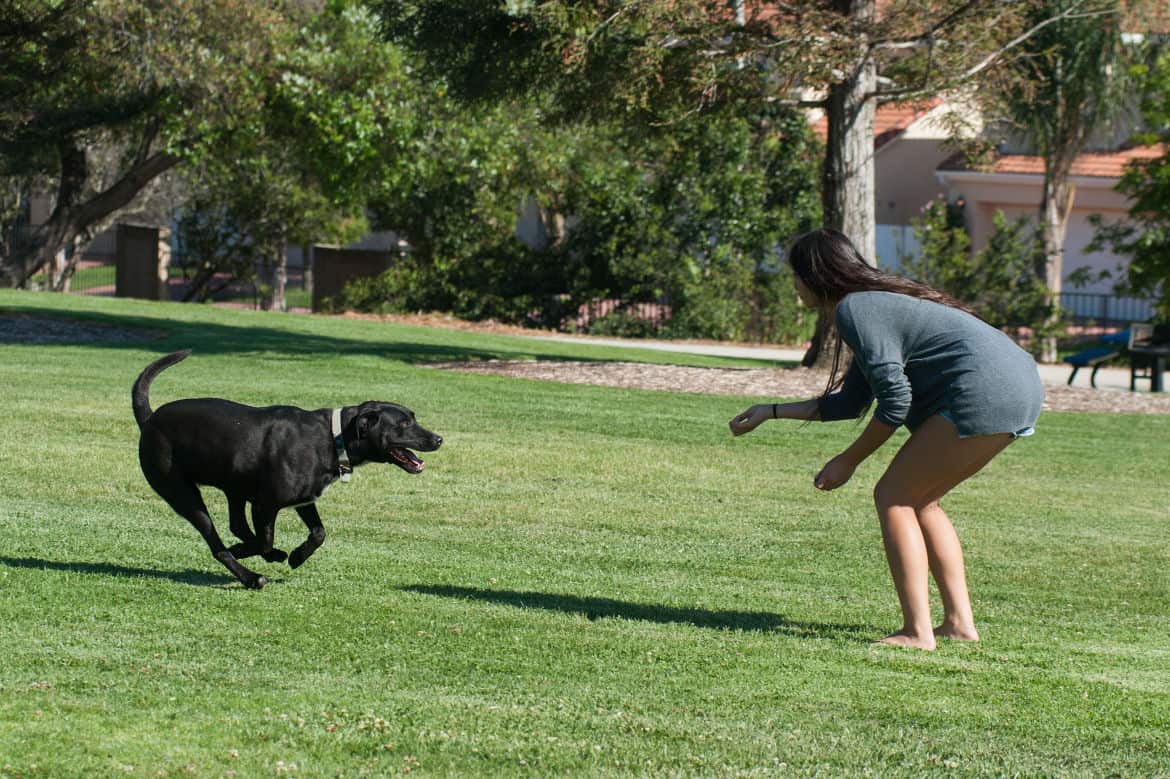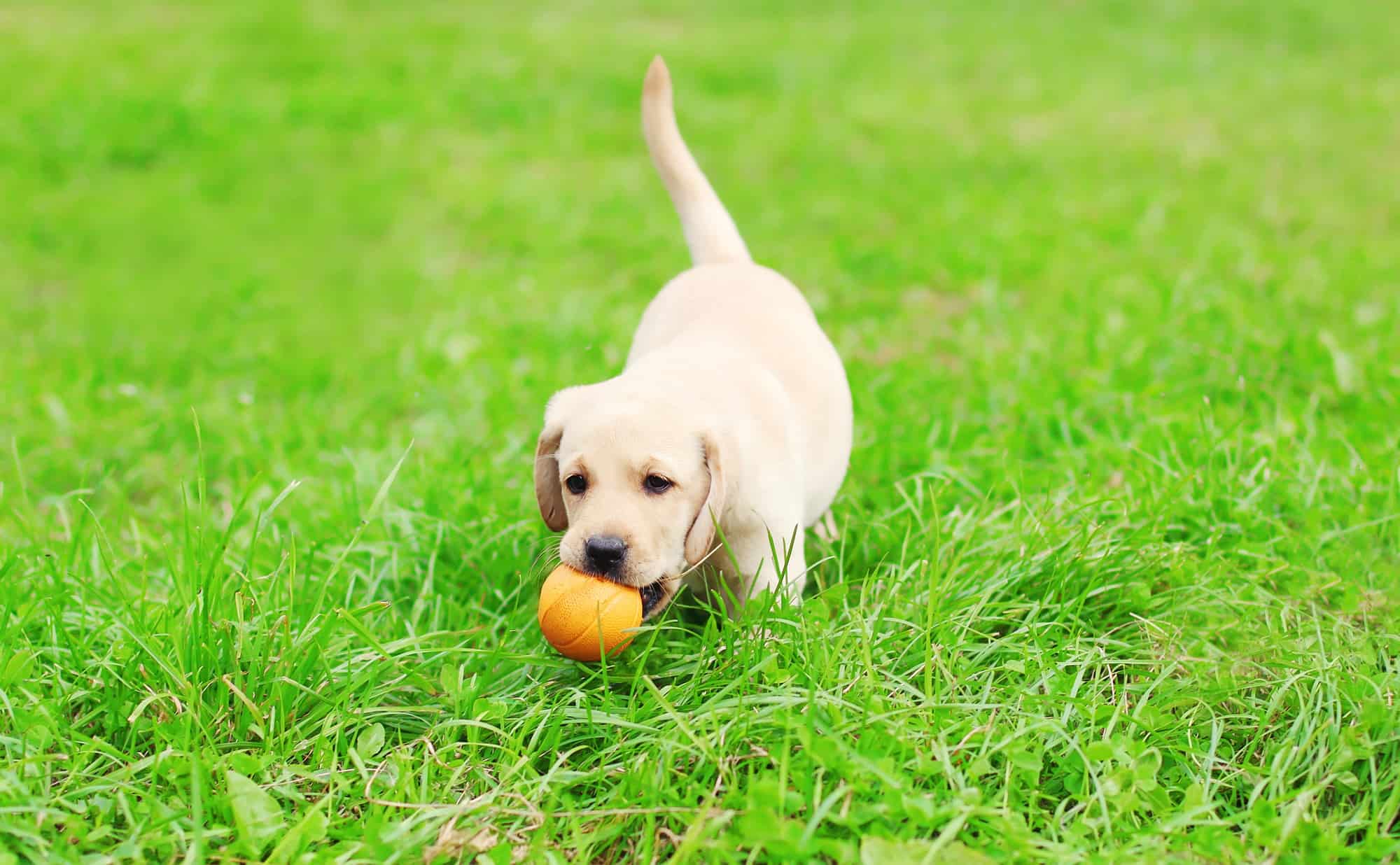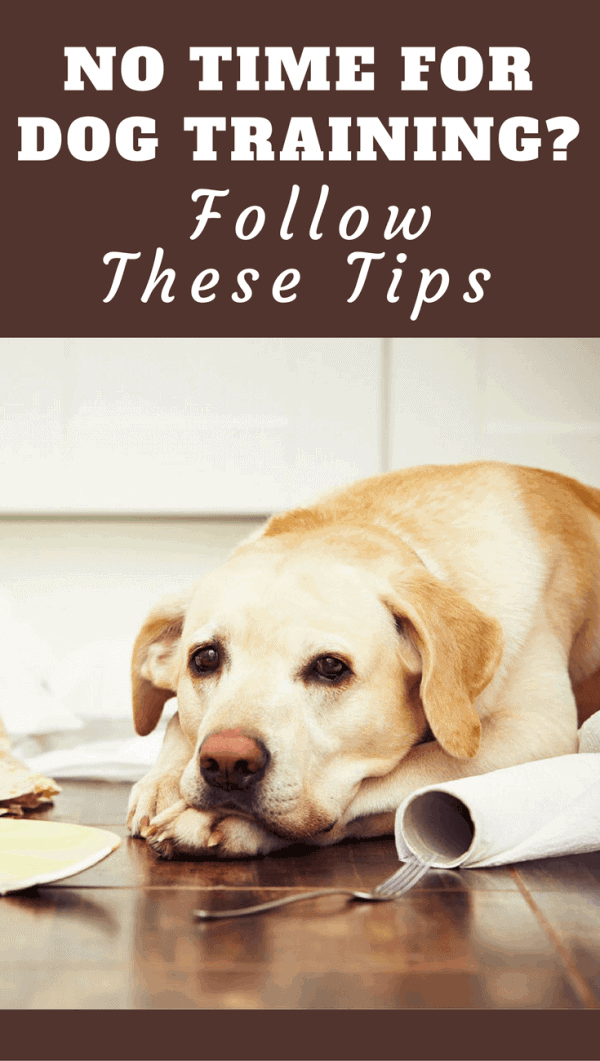This post may contain affiliate links. We may earn money or products from the companies mentioned in this post.

You love your dog. We know you do, but sometimes dog ownership can be downright exasperating. You know what I mean?
They chew up your boots, dig in the garden, jump on the neighbors, and like most respectable dog owners, you’ve tried to work with your pup on stopping those bad habits. But there’s only so many hours in a day, and dog training is so much work!
What if I told you the above statement is only partly true? What if I told you that you could train your dog in just ten minutes a day, while doing things you’re already doing?
That’s right EVERYBODY has time to train their dog if they go about it the right way. You CAN fit dog training into your busy and hectic life. Really, you can!
We’ve Got a Dog-Training Solution for You
First, let me start by saying that you owe it to yourself and your dogs to provide them with basic obedience training.
Not only will it strengthen your relationship with your dog, but it will also help them live a happier, healthier life.
A trained dog has more freedom than their untrained counterparts, and they are a pleasure to walk, travel and adventure with.
I’m not going to tell you that owning a dog isn’t a lot of work. If you have a dog, you probably already know that. Dogs need care, companionship, exercise, love, and yes- training.
But you can work the training into your everyday routines – while watching tv, checking the mail, exercising or making dinner.
You can train your dog a little bit at a time throughout the day with very little effort or commitment of your time.
If you are reading this thinking, “I just don’t have time to train my dog,” this article is for you!
No Matter How Busy You Are, You Have to Train Your Dog
So why not sneak a bit of training into things you’re already doing? Every single day you already:
- Feed your dog
- Talk to your dog
- Pet your dog
- Walk with your dog
- Play games with your dog
- Take your dog out to the bathroom
- Take your dog’s leash on and off
These tasks are great opportunities for your dog to learn!
And let’s face it, we all know that teaching our dogs manners and basic obedience is a good thing. Now we just have to make it happen.
(Almost) Nothing in Life is Free
I’m sure you’ve heard of the dog training method “nothing in life is free”? It’s a popular way of teaching good manners while sneaking in a little dog training every day.
It is, in fact, an entirely sound training philosophy – a way of living with your dogs while helping them behave.
Nothing in Life is Free (NILIF) uses everyday interactions to teach your dog good manners.
But why do I say ‘almost’ nothing in life is free? More on that a little later.
With NILIF Your Dogs Have To Earn Everything
In theory, this means that your dog will not get scratches behind the ears, treats, walks, or games of fetch without earning it first by performing trained behaviors.
Training opportunities are everywhere, and the best time to start is right now. You can tailor this program to meet yours and your dog’s individual needs. For example:
- Before you go for a walk with your dog – Make him sit while you lace up your shoes. Ask him to lie down as you attach the leash to his collar. One last sit before you open the door, and the reward – a long walk with his favorite person.
- While walking – If your dog is a puller, he can earn each step by walking next to you. If he pulls or drags you, the two of you simply stop moving. When he lets up on the leash, you continue moving forward. Your dog will quickly learn how to get what he wants – To move forward, but only by walking nicely at your side.
- While you prepare your dog’s dinner – Ask your dog for a down-stay while you prepare his food. Don’t let him have his food bowl unless he patiently holds the stay until you release him. The food is the reward.
- Before throwing a ball or a toy – Ask your pup to roll over, shake hands, play dead, or any other interesting trick you’ve been working on together. Reward him by throwing the ball.
Get the idea?
The opportunities are only limited by your imagination and can be used to teach your dog just about anything without a massive investment of time.
This is an excellent program for busy dog owners because interactions are integrated seamlessly into your day-to-day life. It’s all about multi-tasking, working training into normal daily activities.
I mean, you’re walking to the mailbox anyway — might as well work a little training into your trip. Once you start thinking like this, you’ll realize that there are hundreds of ways to work in training throughout the day.
Why ALMOST Nothing in Life is Free?
So, previously I mentioned following almost nothing in life is free, so what did I mean and why did I say it?
It’s because to follow the NILIF program to the letter would take an incredible amount of work, concentration, and stress on both sides.
Although people do it, personally I do not see how you can give your dog NOTHING unless they perform a behavior for you. I don’t even see why you’d want to try that?
Instead of NILIF, practice ‘almost nothing in life is free’. Make the program work for you — use it when you have time. Sometimes you need to just get a walk over with, feed your dog and rush off to work. No time for NILIF.
Other times, you want to spoil your dog with a treat and snuggle up with them in front of the TV at night without asking them for three commands first. I say, go for it! Live free at times. Just
I say, go for it! Live free at times. Just try to incorporate training into most little things you do with your dog each day.
The reward of a better behaved and more highly trained dog, without you having to dedicate time out of your day for it will be worth it.
How to Reward Your Dog for Doing What You Ask

Rewards come in many shapes and sizes and are different for every dog.
What makes your dog do cartwheels of excitement? Use that to your advantage. Here are some common rewards and how to use them.
Treats
Low-value treats like regular dog food work well for some dogs. For others, you may have to get creative, using bits of cheese, hot dogs, or dried tuna fish.
You can also buy pretty exciting treats meant for training. If your dog responds well to food rewards, you’re in luck.
Hang a treat pouch from your belt to use throughout the day. When you ask your dog for a command and they obey, be sure to reward them with a treat from your pouch.
For more details about training with treats, read this in-depth article.
Praise
Many dogs who aren’t interested in food rewards want nothing more than to please you. For these dogs, praise and petting take the place of treats.
Fun and Games
Instead of playing with your dog every time they start pacing around the house, make them earn it.
Ask your dog to sit or lie down before throwing them a ball. If your dog brings you a toy for a game of tug, be sure to make them work for it.
Don’t allow them to demand playtime by barking, whining, or pawing you. Ignore that behavior and only reward the behaviors you want to see.
Walks
Your dog can earn special privileges while you’re walking together. What dog doesn’t enjoy the smell-fest that accompanies most walks?
Instead of letting your dog pull you toward smells or other interesting things, make them ask for permission.
If your dog pulls toward something while walking, stop dead in your tracks. That’s not the way to get what you want. Wait for your dog to stop and look at you. When they do, loosen the leash a bit and say, “go check it out.”
Before long your dog will walk calmly by your side, knowing that there will be ample opportunities for them to check stuff out along the way.
This is Only A Small Sample – Use Your Imagination
The rewards listed above are just a small sample of examples. Part of the premise of NILIF is rewarding your dog with whatever you were going to do for them anyway. Of which, you will find many more than is listed.
Extra rewards do come in handy, though. Your dog may not think getting the mail is a reward in and of itself, and I’m almost certain they won’t look at nail-clipping, teeth-brushing or ear-cleaning that way.
But a little something extra will almost certainly do the trick in many situations.
Using NILIF with Puppies

Puppies are like little sponges — eager to learn and eager to please. They will happily follow you around the house, the yard, and the neighborhood learning good manners and obedience along the way.
If you are working with a puppy, consider yourself lucky. Puppies as young as eight weeks can learn crate acceptance, food manners, and proper toileting skills.
Yes, training puppies is much easier than helping an older dog unlearn bad habits. So take advantage of the blank canvas they offer and teach them good behavior and skills right from the get go.
Using NILIF with Older Dogs
The benefit to using NILIF with older dogs, especially newly adopted dogs, is it will immediately begin to strengthen the bond between you and your pooch.
Instead of focusing on punishment, the program focuses on positively rewarding behaviors you want to see. Not only does this help dogs feel good about their behaviors, but it also helps them feel good about you.
Older dogs who have to unlearn certain behaviors may not understand the NILIF program right away.
If your dog doesn’t do what you ask immediately, they get nothing. No scratches behind the ears, no sweet talk, and certainly no treats or playtime.
Ignore your dog for 30 seconds or so and then ask them again for that sit or down. If they comply, be lavish with your praise, treats, or whatever reward you were working toward.
However, if they fail the task again, be lenient. They deserve love, treats, walks and more, so don’t deny them completely. Let them have it and try again later.
If your dog is new to the whole training game, go slow. There’s nothing like a major disruption to the household routine to set your pup up for failure.
Older dogs are set with a certain way of living that you are now trying to change and this can take time. So be patient and a lenient.
Instead, teach a few new obedience skills or manners over weeks, and create good habits slowly. This will help you and your dog be successful.
When Not to Train Your Dog
‘Nothing in Life is Free’ is a convenient and pleasant way to integrate training into everyday life with your dog. You don’t have to practice these techniques all the time though to reap the benefits.
In fact, you and your dog will probably get more out of NILIF if you start by incorporating it into a few situations that need work – perhaps at feeding time or when visitors come to the door.
Before long it will become a natural part of your day. Of course, you should refrain from doing any training exercises if:
- You aren’t feeling well
- You are angry, frustrated, or upset
- You are tired or lacking patience
- Your dog is too distracted to work with you (you have to build up to these types of situations)
- Your dog isn’t feeling well
Conclusion
Like most endeavors, you get out of dog training what you put into it.
Of course, you will achieve faster results if you’re home working with your dog all day, but you won’t see ANY results if you do nothing.
The strategies outlined above are for everyone, but especially those with a busy schedule. The bottom line is — if your dog wants something from you, you can ask them to do something first to earn it.
Over time, the result is a dog that will begin to pay closer attention to you, wondering what’s going to happen next.
They will begin to think that training happens all the time — not just when you’re wearing the treat pouch or holding the leash.
You’ll find that this type of training goes a long way toward strengthening the bond between you and your dog, and good manners and obedience will become a natural part of your everyday life together.
No matter how busy you are, you owe it to yourself and your dog to integrate basic training into your days. ‘(Almost) Nothing in Life is Free’ training can help you succeed on this path.
Save to Pinterest:

Top Picks For Our Dogs
- BEST PUPPY TOY
We Like: Calmeroos Puppy Toy w/ Heartbeat and Heat Packs - Perfect for new puppies. Helps ease anxiety in their new home. - BEST DOG CHEW
We Like: Bones & Chews Bully Sticks - All of our puppies love to bite, nip, and chew. We love using Bully Sticks to help divert these unwanted behaviors. - BEST DOG TREATS
We Like: Crazy Dog Train Me Treats - One of our favorite treats for training our service dog puppies. - BEST FRESH DOG FOOD
We Like: The Farmer's Dog - A couple months ago we started feeding Raven fresh dog food and she loves it! Get 50% off your first order of The Farmer's Dog.
For a list of all the supplies we get for our new service dog puppies check out our New Puppy Checklist on the PuppyInTraining.com blog.
10 comments
Great tips and Almost NILIF is by my opinion the best approach, no matter how busy you are. In fact we used it while not thinking that we are training, it became part of our daily life – you can’t get out if you’re not calm, spin for a ball….and later I realized she learned lot’s of words that weren’t meant to be commands. Great article!
Thanks Ana :-)
My dog is a little over a year. He is a mess. I have tried to teach him not to get into things, chase stuff, take off, etc. Hoping this works.
my dog is a mixture of golden and laberador, it’s now 4 months old
i failed in training hi, to putty in the bathroom….every time he walks in the flat he makes it on the carpet :(
i really don’t know how to make it, although once he did it in the bathroom i give him a treat and play with him and once he did it on the carpet outside i put a tissue and returns it back to the bathroom
please help!!! i love him but can’t leave him doing that all the time :(
Hi Sherry,
Please check our detailed guide to house training found in the training section, it should have all the advice you need.
I like how basic these training tips are! Like, making your dogs dinner, make them sit and wait. I’ll be sure to work on that his my puppy. Food is his favorite part of the day, so he always gets really excited. I’ll be sure to start making him sit and wait while I get it ready. He’s still a puppy, so he has time to learn.
My lab is 8 months old now and is getting worse at night for sleeping getting me up 3 or 4 times a night won’t settle back in his crate so I leave him out but within half an hour he will destroy anything he can get his paws on usually off work surfaces loves to destroy books, I slept more with my new born babies than this dog! He’s my 4 th Lab over the last 20 years and I’m at my wits end! Please help
Thank you for your informative article! I appreciate your approach of “almost” NILIF. We are all human and cannot devote every minute of every day to living and breathing by a set of rules but I agree with you that as long as we keep a well-structured life and keeping these rules in mind it will inevitably make for a well-trained companion.
What I would love to add is there are indoor options when walking outside is not an option. A dog treadmill can give you pup a workout routine based on your own schedule. When making coffee first thing in the morning for example, I know of people that will start their pooch on a light trot on their home dog treadmill. This satisfies your dog until you can get back from work, and then try for outside. If weather or convenience still is an issue, you could the dog back on the treadmill (or treadwheel) for a more rigorous exercise. This would meet their need for 30 minutes of exercise daily more consistently.
My friend made a mistake of adopting a pit bull, he would get aggressive and always barked at the strangers, I was always scared of getting close to him whenever I visited her on holidays. Even though i was a familiar face to the dog, he would simply bark at me and scare the hell out of me. Thank you for sharing the article, it is so full of information. It’s not that I don’t love dogs, I own two chihuahuas myself and they are quiet friendly its just that it’s difficult to train some dog breeds and Pit bulls are one of such breeds.